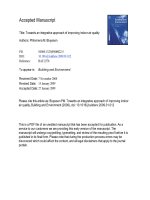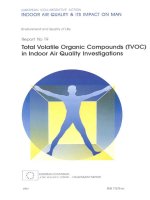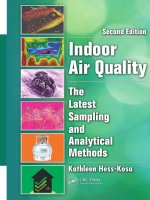INDOOR AIR QUALITY MONITORING FOR SMART BUILDING
Bạn đang xem bản rút gọn của tài liệu. Xem và tải ngay bản đầy đủ của tài liệu tại đây (13.96 MB, 50 trang )
VIETNAM NATIONAL UNIVERSITY, HANOI
UNIVERSITY OF ENGINEERING AND TECHNOLOGY
Doan Ba Cuong
INDOOR AIR QUALITY MONITORING FOR
SMART BUILDING
Major: Electronics and Communications
Hanoi - 2016
VIETNAM NATIONAL UNIVERSITY, HANOI
UNIVERSITY OF ENGINEERING AND TECHNOLOGY
Doan Ba Cuong
INDOOR AIR QUALITY MONITORING FOR
SMART BUILDING
Major: Electronics and Communications
Supervisor: Assoc. Prof. Dr. Tran Duc Tan
Hanoi - 2016
AUTHORSHIP
I hereby declare that the work contained in this thesis is of my own and has not
been previously submitted for a degree or diploma at this or any other higher education
institution. To the best of my knowledge and belief, the thesis contains no materials
previously or written by another person except where due reference or acknowledgement
is made.
Signature: . . . . . . . . . . . . . . . . . . . . . . . . . . . . . . . . . . . . . . . . . . . . . . . . . . . . . . . . . . . . .
i
SUPERVISOR’S APPROVAL
I hereby approve that the thesis in its current form is ready for committee examination as a requirement for the Bachelor of Electronics and Communications degree at the
University of Engineering and Technology.
Signature: . . . . . . . . . . . . . . . . . . . . . . . . . . . . . . . . . . . . . . . . . . . . . . . . . . . . . . . . . . . . .
ii
ACKNOWLEDGEMENT
I would like to express my sincere gratitude to my supervisor Assoc. Prof. Dr Tran
Duc Tan to his constant support, guidance and motivation, his valuable feedback and
useful comments which made my research a very rich experience. It would never have
been possible for me to take this work to completion without his incredible support and
encouragement.
I am grateful to BSc. Nguyen Dinh Chinh who always facilitate me to do this thesis,
answer my questions in a familiar way and share his experience for me as well as make
me feel comfortable and better in studying.
I would like to also thank to members of the Faculty of Electronics and Communications,
VNU-UET for their enthusiasm to guide me to for the background of knowledge.
I greatly appreciate the following organizations the Department of Micro-Electro-Mechanical
Systems and Microsystems, Faculty of Electronics and Communications, University of Engineering and Technology for providing me with an ideal research environment.
Finally I would also like to thank to my parents who sacrificing their whole life for me,
for their unconditional support, encouragement and loves.
Doan Ba Cuong
iii
ABSTRACT
Nowadays, many developing countries are suffering from air pollution, especially buildings in the big cities. While quite a few air quality monitoring devices have been built by
governments in buildings. However, the quality of indoor air inside offices, schools, and
other workplaces is important not only for workers’ comfort but also for their health. Poor
indoor air quality (IAQ) has been tied to symptoms like headaches, fatigue, trouble concentrating, and irritation of the eyes, nose, throat and lungs. Also, some specific diseases
have been linked to specific air contaminants or indoor environments, like asthma with
damp indoor environments. So, this thesis research on a system to monitor the poison gas
in citizen in order to warn and protect human health. The system is a local network and
nodes send the data to the gateway. People can access the data from anywhere, anytime
with only your smart phone, computer (any devices can connect to the Internet) and the
Internet.
iv
TABLE OF CONTENTS
List of Figures
vii
List of Tables
viii
ABBREVATIONS
ix
1 INTRODUCTION
1
1.1
Motivation . . . . . . . . . . . . . . . . . . . . . . . . . . . . . . . . . . .
1
1.2
Contributions and thesis overview . . . . . . . . . . . . . . . . . . . .
2
2 SYSTEM INTEGRATION
2.1
2.2
2.3
3
Components . . . . . . . . . . . . . . . . . . . . . . . . . . . . . . . . . .
3
2.1.1
Waspmote . . . . . . . . . . . . . . . . . . . . . . . . . . . . . . . .
3
2.1.2
Module Xbee . . . . . . . . . . . . . . . . . . . . . . . . . . . . . .
6
2.1.3
Waspmote Prototyping Board 2.0 . . . . . . . . . . . . . . . . . . .
7
2.1.4
Gas Sensor(MQ-2) . . . . . . . . . . . . . . . . . . . . . . . . . . .
8
2.1.5
Gateway Module(Coordinator)
2.1.6
Power Management . . . . . . . . . . . . . . . . . . . . . . . . . . . 12
Wireless Sensor Network(WSN) . . . . . . . . . . . . . . . . . . . . . 13
2.2.1
Introduction . . . . . . . . . . . . . . . . . . . . . . . . . . . . . . . 13
2.2.2
WSN Routing . . . . . . . . . . . . . . . . . . . . . . . . . . . . . . 15
2.2.3
Node Feature . . . . . . . . . . . . . . . . . . . . . . . . . . . . . . 17
ZigBee and IEEE 802.15.4 . . . . . . . . . . . . . . . . . . . . . . . . . 22
3 PROPOSED METHOD
3.1
. . . . . . . . . . . . . . . . . . . . 11
Calibration
3.1.1
25
. . . . . . . . . . . . . . . . . . . . . . . . . . . . . . . . . . 25
Why do we need to calibrate sensors? . . . . . . . . . . . . . . . . . 25
v
3.1.2
3.2
How to calibrate sensors?
. . . . . . . . . . . . . . . . . . . . . . . 26
Data frame . . . . . . . . . . . . . . . . . . . . . . . . . . . . . . . . . . 27
3.2.1
ASCII Frame . . . . . . . . . . . . . . . . . . . . . . . . . . . . . . 27
3.2.2
Binary Frame . . . . . . . . . . . . . . . . . . . . . . . . . . . . . . 29
4 RESULTS AND DISCUSSIONS
30
4.1
Data transfer rate . . . . . . . . . . . . . . . . . . . . . . . . . . . . . . 31
4.2
A system’s life time . . . . . . . . . . . . . . . . . . . . . . . . . . . . . 34
5 CONCLUSIONS
36
5.1
Conclusions . . . . . . . . . . . . . . . . . . . . . . . . . . . . . . . . . . 36
5.2
Future Works . . . . . . . . . . . . . . . . . . . . . . . . . . . . . . . . . 36
REFERENCES
37
vi
List of Figures
2.1
Kit Waspmote . . . . . . . . . . . . . . . . . . . . . . . . . . . . . . . . . .
3
2.2
Details Kit Waspmote . . . . . . . . . . . . . . . . . . . . . . . . . . . . .
4
2.3
Waspmote block diagrams – Data signals . . . . . . . . . . . . . . . . . . .
5
2.4
Waspmote block diagrams – Power signals . . . . . . . . . . . . . . . . . .
6
2.5
Module Xbee . . . . . . . . . . . . . . . . . . . . . . . . . . . . . . . . . .
7
2.6
Prototype V2.0 . . . . . . . . . . . . . . . . . . . . . . . . . . . . . . . . .
8
2.7
Gas sensor MQ-2 . . . . . . . . . . . . . . . . . . . . . . . . . . . . . . . .
9
2.8
MQ-2 Sensitivity Characteristics . . . . . . . . . . . . . . . . . . . . . . . . 10
2.9
Influence of Temperature/Humidity . . . . . . . . . . . . . . . . . . . . . . 11
2.10 Gateway Module . . . . . . . . . . . . . . . . . . . . . . . . . . . . . . . . 11
2.11 Battery . . . . . . . . . . . . . . . . . . . . . . . . . . . . . . . . . . . . . 12
2.12 Wireless Sensor Network . . . . . . . . . . . . . . . . . . . . . . . . . . . . 13
2.13 Waspmote Gateway connected in a PC . . . . . . . . . . . . . . . . . . . . 17
2.14 LEDs and buttons in Waspmote Gateway
. . . . . . . . . . . . . . . . . . 18
2.15 XBee Configuration & Test Utility (XCTU) . . . . . . . . . . . . . . . . . 19
2.16 End Device . . . . . . . . . . . . . . . . . . . . . . . . . . . . . . . . . . . 21
2.17 Waspmote IDE on Windows . . . . . . . . . . . . . . . . . . . . . . . . . . 22
2.18 ZigBee and IEEE 802.15.4 . . . . . . . . . . . . . . . . . . . . . . . . . . . 23
3.1
Flow chart to calibrate MQ-2 sensor. . . . . . . . . . . . . . . . . . . . . . 26
4.1
System modeling.
4.2
System modeling in case 3 node and 5m,7m,10m distance respectively. . . . 32
4.3
System modeling in case 3 node and 10m,20m,50m distance respectively. . 33
4.4
Concentration of LPG, CO and SMOKE for a period of time . . . . . . . . 34
. . . . . . . . . . . . . . . . . . . . . . . . . . . . . . . 30
vii
List of Tables
2.1
Table of Waspmote specifications . . . . . . . . . . . . . . . . . . . . . . .
3.1
ASCII Frame . . . . . . . . . . . . . . . . . . . . . . . . . . . . . . . . . . 27
3.2
ASCII Header . . . . . . . . . . . . . . . . . . . . . . . . . . . . . . . . . . 27
3.3
Binary Frame . . . . . . . . . . . . . . . . . . . . . . . . . . . . . . . . . . 29
4.1
ASCII Frame of the system . . . . . . . . . . . . . . . . . . . . . . . . . . 30
4.2
Data transfer rate in case 1 node and 5m distance.
4.3
Data transfer rate in case 3 node and 5m,7m,10m distance respectively.
. 32
4.4
Data transfer rate in case 3 node and 10m,20m,50 distance respectively.
. 33
viii
4
. . . . . . . . . . . . . 31
ABBREVATIONS
ADC
Analog to Digital Converter
CPU
Central Processing Unit
DIP
Dual In-line Package
DSP
Digital Signal Processing
EEPROM
Electrically Erasable Programmable Read-Only Memory
EPI
Environmental Performance Index
FET
Faculty of Electronics and Telecommunications
GPS
Global Positioning System
GPRS/3G
General Packet Radio Service/Third Generation
I2C
Inter-Integrated Circuit
IAQ
Indoor Air Quality
IEEE
Institute of Electrical and Electronics Engineers
LPG
Liquefied Petroleum Gas
MAC
Medium Access Control
MANET
Mobile Adhoc Netwok
MEMS
Micro-Electro-Mechanical Systems
PAN ID
Personal Area Network Identifier
PPM
Parts Per Million
PWM
Pulse Width Modulation
RH
Relative Humidity
RTC
Real Time clock
ix
SMD
Surface-Mount Packages
SPI
Serial Peripheral Interface Bus
SRAM
Static Random-Access Memory
WSN
Wireless Sensor Network
VNU
Viet Nam National University
UET
University of Engineering and technology
UART
Universal Asynchronous Receiver/Transmitter
USB
Universal Serial Bus
x
Chapter 1
INTRODUCTION
1.1
Motivation
Indoor Air Quality (IAQ) refers to the air quality within and around buildings and
structures, especially as it relates to the health and comfort of building occupants. Understanding, controlling common pollutants indoors and monitoring poison gas level can
help reduce your risk of indoor health concerns and improve the quality of life.
Nowadays, the environment has been contaminated. Pollution is a big problem in any
country. The environmental pollution is alarming in Vietnam. ”Vietnam is ranked 79th
the lower part in the middle group. But on specific detailed criteria, Vietnam displayed
even worse performance, including air quality with effects on human health, water, and
environmental burden of disease”. Air quality in Vietnam is lagging among the ten worst
nations in the world, ranking 123rd, and it is forecast that air pollution will continue to
worsen in the near future and may fall to 125th place, according to the EPI survey. This
information, while alarming, is now new, as independent surveys by Vietnamese agencies
have reached the conclusion that the country’s air pollution has worsened at a steady rate
and has reached an alarming level, said Ph.D. Ngo Duc The – a Vietnamese professor of
the National University of Singapore. Smoke and dust created by trucks are the main
factors leading to the decline in air quality in Vietnam, especially in major cities like
Hanoi and Ho Chi Minh City[1].
In our lifetime, we each spend tens of thousands of hours at work. Poor quality indoor
air can cause major health problems, such as allergies and respiratory diseases. And
even the minor ailments, such as headaches and eye irritation, can cause discomfort and
distraction that can ultimately lead to lower productivity. In additions, a lot of people
1
live in apartment in buildings with poor air conditional. Moreover, patients in a hospital
breath in poor air quality without knowing that, students studies while poison gas around
them in school and some similarly case.
People need a system to control air condition to protect health’s citizen, the system in
this thesis can help you with innovative solutions to suit your workplaces and buildings.
1.2
Contributions and thesis overview
The system in this thesis is intended to help people who work, live, study in office
buildings to monitoring the poison gas that including some common gases such as LPG,
CO, CO2, Alcohol, Smoke, Propane, CH4 and warning when the level of poison gas exceed
the allowed threshold in order to maintaining a good indoor environment and reduce the
risk for our’s health. However, good indoor air quality also depends on the actions of
everyone in the building, a partnership between building management and occupants is
the best way to maintain a healthy and productive work space.
The system using some devices to create a local network by using Zigbee communications. In other way, this system called wireless sensor network (WSN). At each
node(device), the raw data read from Gas sensor(MQ-2) will be calibrated depend on
temperature and humidity. After that, the data will be send to the gateway to analyze
and processing. Lastly, level of poison gas will be send to the Internet. Therefore, people
can be accessed them anytime, anywhere from the Internet.
The rest of this thesis is organized as follows.
Chapter 2 provides theoretical background, focusing on application poison gas monitoring
system and architecture of WSN.
In Chapter 3, Explains the the proposed method to design and set up the integrate system.
In Chapter 4, Some experimental results with real dataset and discussion.
In Chapter 5, Conclusions and directions for future work.
2
Chapter 2
SYSTEM INTEGRATION
2.1
2.1.1
Components
Waspmote
a, Waspmote Introduction
Figure 2.1: Kit Waspmote
Waspmote is the brand name of a modular platform created by Libelium and used in
Wireless Sensor Networks (WSN). A wireless sensor network (WSN) consists of spatially
distributed autonomous sensors to monitor physical or environmental conditions, such
as temperature, sound, vibration, pressure, motion or pollutants and to cooperatively
compute their data through the network. The WSN is built of nodes, in this case each
node is a Waspmote module. The idea of a modular architecture is to integrate only the
modules needed in each device. Modules can be changed and expanded depending on the
needs, this is the strong point of the platform.
3
b, Specifications.
Figure 2.2: Details Kit Waspmote
Table 2.1: Table of Waspmote specifications
General data:
Microcontroller:
Frequency:
SRAM:
EEPROM:
FLASH:
SD Card:
Weight:
Dimensions:
Temperature Range:
Clock:
Consumption:
ON:
Sleep:
Deep Sleep:
Hibernate:
Operation without recharging:
Battery voltage:
Solar panel charging:
USB charging:
ATmega1281
14.7456 MHz
8 KB
4 KB
128 KB
2 GB
20 gr
73.5 x 51 x 13 mm
[-10 o C, +65o C ]
RTC (32KHz)
c, Built-in sensors on the board.
• Temperature (±): -40o C , +85o C. Accuracy: 0.25o C
• Accelerometer: ±2g/±4g/±8g
4
15 mA
55 µm
55 µm
0.07 µm
1 year *
3.3 V - 4.2V
6 - 12V -280mA
5 V - 100mA
d, Inputs/Outputs.
• 7 Analog (I), 8 Digital (I/O), 1 PWM, 2 UART, 1 I2C, 1 USB, 1 SPI.
e, Block Diagram.
Figure 2.3: Waspmote block diagrams – Data signals
The XBee module, the ICSP connector and USB connector share the same UART,
so these modules can’t work simultaneously. This feature creates most of the problems
communicating with the board. However, we can obtain the expansion radio board and
connect the XBee module in UART1.
The other microcontroller UART is connected to a four channel multiplexer, and it
is possible to select in the same program which of the four new channels is required to
5
connect to the UART on the microcontroller. These channels are connected as follows.
One is connected to the GPRS/3G board, the other to the GPS and the other two are
accessible to the user in the auxiliary I2C – UART connector.
The I2C communication bus is also used in Waspmote where three devices are connected in parallel: the accelerometer, the RTC and the digital potentiometer (digipot)
which configures the low battery alarm threshold level. In all cases, the microcontroller
acts as master while the other devices connected to the bus are slaves. The SPI port on
the microcontroller is used for communication with the micro SD card.
Figure 2.4: Waspmote block diagrams – Power signals
2.1.2
Module Xbee
The XBee Modules were engineered to meet IEEE 802.15.4 standards and support
the unique needs of low-cost, low-power wireless sensor networks. The modules require
minimal power and provide reliable delivery of data between devices.
6
Figure 2.5: Module Xbee
2.1.3
Waspmote Prototyping Board 2.0
The Waspmote Prototyping Board 2.0 has been designed to make it as easy as possible
for the user to integrate any type of sensor. With this aim in mind, the board has been
endowed with a 16 bit analog-digital converter (ADC) which provides up to a 68uV
resolution in a 0 to 4.5V range for a differential input; an area of independent pads where
pins, cables, passives or DIP encapsulated integrated circuits can be welded; and an area
for SMD encapsulated integrated circuits upon which various circuits or sockets with
different sizes can be mounted.
Electrical Characteristics
Operating ratings:
• Board supply voltages: 3.3V and 5V
• Analog-to-Digital converter supply voltage: 5V
• Maximum admitted current (continuous): 200mA
• Maximum admitted current (peak): 400mA
Absolute maximum ratings:
7
Figure 2.6: Prototype V2.0
• Microprocessor pin voltage: -0.5V to 3.8V
• Analog-to-Digital converter input voltage: -0.3V to 5.3V
• Microprocessor pin current: 40mA
2.1.4
Gas Sensor(MQ-2)
Sensitive material of MQ-2 gas sensor is SnO2, which with lower conductivity in clean
air. When the target combustible gas exist, The sensor’s conductivity is more higher
along with the gas concentration rising. Please use simple electrocircuit, Convert change
of conductivity to correspond output signal of gas concentration.MQ-2 gas sensor has
high sensitivity to LPG, Propane and Hydrogen, also could be used to Methane and
8
Figure 2.7: Gas sensor MQ-2
other combustible steam, it is with low cost and suitable for different application.
a, Characteristic.
• Good sensitivity to Combustible gas in wide range
• High sensitivity to LPG, Propane and Hydrogen
• Long life and low cost
• Simple drive circuit
b, Application.
• Domestic gas leakage detector
• Industrial Combustible gas detector
• Portable gas detector
c, Sensitivity characteristics.
The typical sensitivity characteristics of the MQ-2, ordinate means resistance ratio of
the sensor (Rs/Ro), abscissa is concentration of gases. Rs means resistance in different
gases, Ro means resistance of sensor in 1000ppm Hyrogen. All test are under standard
test conditions.
9
Figure 2.8: MQ-2 Sensitivity Characteristics
d, Influence of Temperature/Humidity.
The typical temperature and humidity characteristics. Ordinate means resistance ratio
of the sensor (Rs/Ro), Rs means resistance of sensor in 1000ppm Butane under different
temperature and humidity. Ro means resistance of the sensor in environment of 1000ppm
Methane, 20◦ C/65%RH.
Sensitivity Adjustment
Resistance value of MQ-2 is difference to various kinds and various concentration gases.
So,When using this components, sensitivity adjustment is very necessary. we recommend
that you calibrate the detector for 1000ppm liquified petroleum gas - LPG,or 1000ppm
iso-butane (i-C4H10) concentration in air and use value of Load resistance that( RL)
about 20 KΩ (5KΩ to 47 KΩ). When accurately measuring, the proper alarm point for
the gas detector should be determined after considering the temperature and humidity
influence.
10
Figure 2.9: Influence of Temperature/Humidity
2.1.5
Gateway Module(Coordinator)
Figure 2.10: Gateway Module
Each ZigBee network must have one coordinator. A coordinator has the following
characteristics:
• It selects the channel and PAN ID (both 64-bit and 16-bit) to start the network
11
• It can allow routers and end devices to join the network
• It can assist in routing data
• It can not sleep. It has to be always awake
2.1.6
Power Management
Figure 2.11: Battery
Feature
• High energy density
• Excellent safety performance
• Excellent storage performance and low self-discharge rate
• Wide temperature range, operation from: -20◦ C ∼ +60◦ C
• Environmentally
12
2.2
2.2.1
Wireless Sensor Network(WSN)
Introduction
A wireless sensor network is a collection of nodes organized into a cooperative network.
Each node consists of processing capability (one or more microcontrollers, CPUs or DSP
chips), may contain multiple types of memory (program, data and flash memories), have a
RF transceiver (usually with a single omnidirectional antenna), have a power source (e.g.,
batteries and solar cells), and accommodate various sensors and actuators. The nodes
communicate wirelessly and often self-organize after being deployed in an ad hoc fashion.
Systems of 1000s or even 10,000 nodes are anticipated. Such systems can revolutionize
the way we live and work[2].
Figure 2.12: Wireless Sensor Network
13









